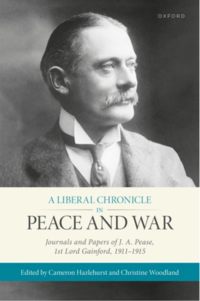BRITISH LIBERALISM ALIVE AGAIN

BRITISH LIBERALISM ALIVE AGAIN
Two former Oxford students have greatly amplified our knowledge of the hey-day of British Liberalism through the little known diary of a Cabinet Minister
Published: September 19 2023
Author: Richard Lofthouse
Share this article

A Liberal Chronicle in Peace and War: Journals and Papers of J. A. Pease, 1st Lord Gainford, 1911-1915 (Oxford University Press, 15 June 2023)
Described by one critic as a work of ‘scholarly art,’ this 596-page book offers a treasure trove to scholars and students of British Liberalism and specifically of the government under H.H. Asquith that fatefully went to war in 1914. An earlier volume published in 1994 covers the period 1908-10. This volume covers the crucial years 1911-15.
Available as an e-book, the hardback is expensive and represents the core of what a university press does by supporting scholarship that expands knowledge.
Yet this particular individual, Jack Pease (1860-1943), may well appeal to a wider audience at a time when apparently politics and public life in the UK finds itself at a low ebb; when there would appear to be again a gaping hole between Conservative and Labour approaches to ideas and government; when by-elections are falling sometimes to Liberal Democrat candidates and when the much-rehearsed question to Oxford history and PPE undergraduates, whether British Liberalism could be revived, seems as relevant as it ever was. And then there are the awful echoes of a major land war where trenches in Ukraine have evoked direct comparisons with the Great War.
>The editors Cameron Hazlehurst (Balliol, 1966) and Christine Woodland (St Anne’s, 1964) spoke to QUAD about the project, shortly after publication of the book by Oxford University Press in June 2023.
Jack Pease was born into a prominent northern Quaker family in 1860 and died eighty-three years later in 1943. Across that long span he never ceased to be the embodiment of an energetic Liberal cut to the shape of a late-Victorian/Edwardian template. For the period covered by the book he was a Cabinet Minister as President of the Board of Education from 1911.
He viscerally disliked the Tories but never fell prey to anything remotely approaching Socialism. This is a man who was Mayor of Darlington at the tender age of 29 and MP for Tyneside three years later in 1892. He hated war and was President of the Peace Society in 1914, but he supported it where he had to. Just at the point where you want to make him one thing or another he eludes you. For instance he liked his blood sports but that’s not all. There is a genuinely funny sentence in the introduction where the editors refer to his ‘favourite pastimes of fishing, hunting, shooting, and embroidery…’
Years later when he was no longer a government minister he fought for water purity on Teesside, calling for a national body to deal with pollution; he supported homeopathy; he became a fervent advocate of the therapeutic value of music, believing it helped with shell-shocked survivors of the trenches; this led in turn to supporting and loving radio when it was as new and as exciting as social media apps or AI are in 2023. He was the first chairman of the BBC, President of the Federation of British Industries in 1927, and later advised the government on re-arming itself in the face of fascism.
Many of these themes reverberate across the decades to our own times, but it was the unvarnished daily record of what was said and done in Downing St and Westminster that made a compelling case for publishing Pease’s diaries. Cameron says ‘here was a man who attended cabinet meetings, went home and wrote up what he thought was important that day. He did so as a conscientious witness, never magnifying his own role.’
The mountain of scholarly work that both editors have conducted intermittently over six decades since discovering the papers seeks to elucidate those Cabinet meeting ‘write-ups’, which are typically written at speed, often allusive or terse, and referring to scores of often little-known actors.
Cameron and Christine pay tribute to Pease’s grandson, the 3rd Lord Gainford, who deposited the family papers in Nuffield College, Oxford, and was a strong supporter of the editing project.
‘To begin with we knew little or nothing about many of the topics Pease mentioned,’ says Cameron.
‘But’, says Christine, ‘advancing scholarship, generations of PhDs and other primary sources coming to light progressively provided context for interpreting Pease’s notes.’
The private correspondence of several senior officials and ministerial private secretaries has come to the surface during the project – letters to mothers and wives of well-connected people like Asquith’s private secretaries Charles Lyell and Eric Drummond.
What are we left with? Christine offers, ‘We tend to see history through the stern black and white photographs of these formidable individuals. But they were warmly human. They were sharing intimate views of people and events in uninhibited personal correspondence.’
The themes of these years are familiar to those who have studied them. The constitutional and Home Rule crises; industrial conflict; electoral reform; women's suffrage controversies; struggles over budgets; seemingly endless debates about naval estimates and spending; foreign policy in the broadest sense but not forgetting a sprawling Empire that it is too easy to overlook, but which occupies a great deal of government discussion as this volume attests.
If one turns to the outbreak of World War One in that fateful August of 1914 – it was not familiar by this name then, of course, – the narrative of those meetings was different to what we might think.
There is a lot of discussion about colonies in the British Empire, about troops from those colonies fighting the British cause, of how to handle German territory in Africa; of buying horses ‘on the quiet’ from Canada to support the British Expeditionary Force. There is disquiet about the very idea of the war, and open disagreement about whether to go to war at all. Some ministers resign. There is a working assumption to start with that it would be principally a naval conflict:
‘It is awful to think that possibly 10,000 of our brave boys who I recently saw cheering their King as they passed at Spithead may be at the bottom of the sea in the course of a few days, & all owing to the wickedness & stupidity of a war party in Germany who control the Emperor.’
This was intensified days later when a German minefield just sixty miles off the coast of Suffolk claims its first British ship, drowning 150 sailors.
As late as August 6 Pease writes that he hopes the Expeditionary Force won’t need to actually go. There is a lively argument about whether it should be six Divisions or four. There is absolutely no understanding of what lay ahead; no premonition of the ‘Western Front,’ trench foot, gas attacks, artillery shell shortages, shell shock, Gallipoli, the Somme.
Rather, the atmosphere here remains touchingly gentlemanly. The war presents as an inconvenient conflict into which the world had been tripped by hotheads, with a very strong desire to avoid unnecessary bloodshed by numerous Liberals imbued with anti-war (if not outright pacifist) values.
Jack wrote in a fast, dense hand. Almost everything he jots down requires further explanation so the editors provide it there and then, in footnotes and in linking commentary. It is absolutely invaluable and brings everything to life, resurrecting a whole world of relationship and nuance.
Inevitably A Liberal Chronicle will be a reference resource to many scholars for years to come, but it richly rewards even the cursory glance and is the best reminder of how much we load the past with our own hindsight, and how difficult it is to steer a course through a crisis as huge as a major war.
Jack’s gut instinct that the outcome would be terrible, was of course right.
Both editors confirm that they warmed to their subject, which is just as well when you spend as many years as they have studying him.
They summarise their work thus:
‘The Pease journals from 1911 to 1915 are an invaluable chronicle of Liberal government in peace and war. They provide an authentic and closely observed record of the Asquithian political world, the Prime Minister’s family, and the social circle that revolved around him. By contrast with those of his colleagues who seemed intent on compiling evidence of their own prescience, insight, and political courage, Jack Pease was content to be a witness to ‘history’.’
Cameron Hazlehurst is an Oxford DPhil and former Queen’s and Nuffield College research fellow, today Hon. Professor, Humanities Research Centre, Australian National University; Christine Woodland, Ethel Simon Scholar at St Anne’s College, Oxford and former head of the Modern Records Centre at Warwick University, today Independent scholar and retired archivist.
Lead Picture: US troops begin a parade on Westminster Bridge, London, September 5, 1917. (Shutterstock)
The book can be ordered with a large alumni discount here: https://global.oup. com/academic/ with promotion code AAFLYG6
Reviews and other material about the book are collated by OUP HERE.















